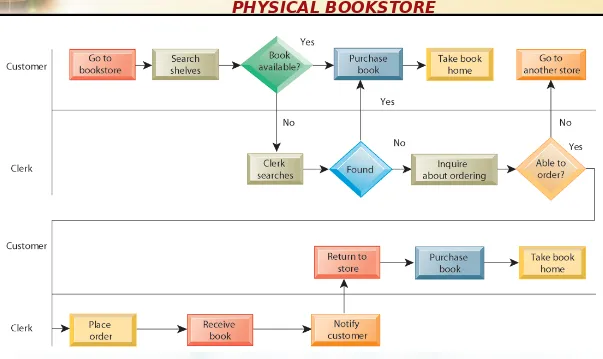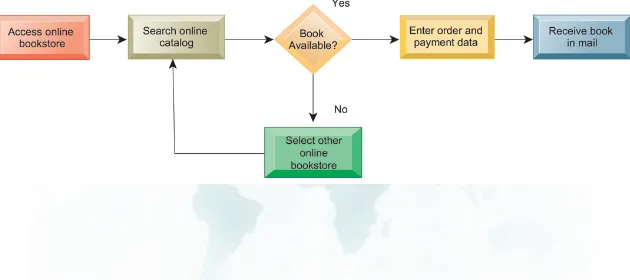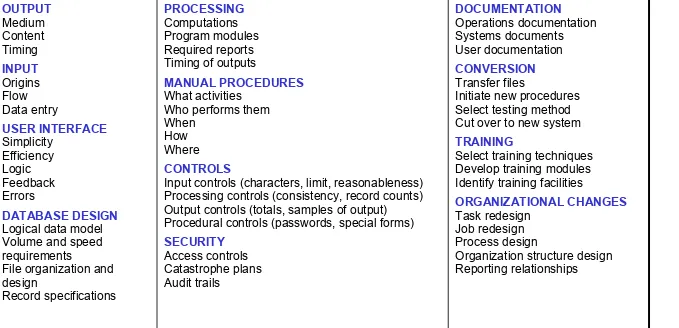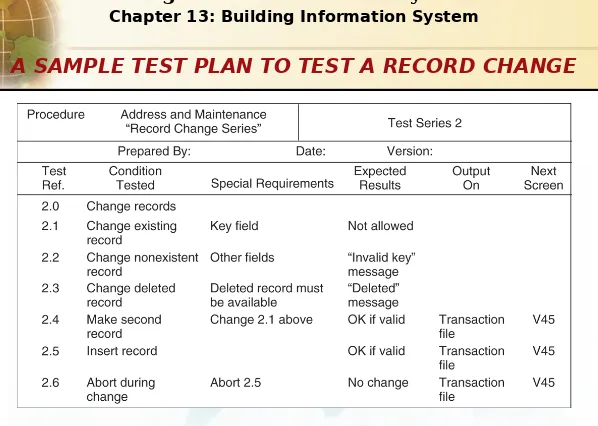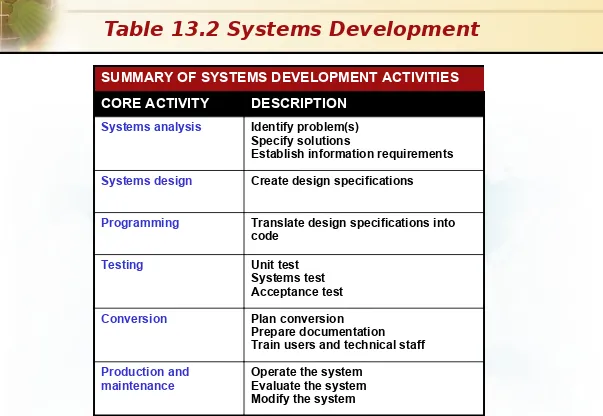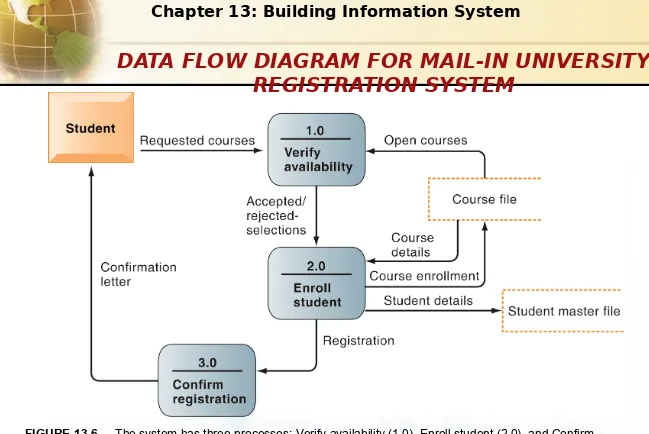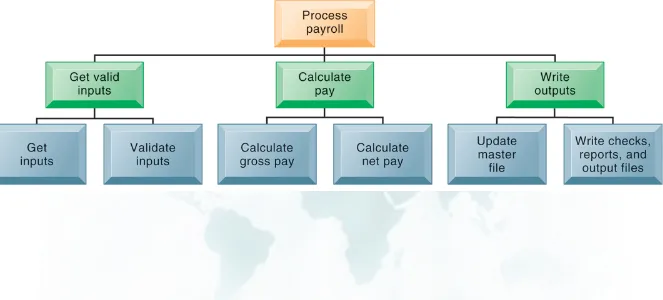6.1
Copyright © 2014 Pearson Education, Inc. publishing as Prentice
Hall
Building
Information
Systems
Chapter 13
VIDEO CASES
Video Case 1: IBM: Business Process Management in a SaaS
Environment
Video Case 2: IBM Helps the City of Madrid With Real-Time BPM
Software
Instructional Video 1: BPM: Business Process Management
Customer Story: Besthome Store
13.2
Copyright © 2016 Pearson Education Ltd.
Management Information Systems
Chapter 13: Building Information System
•
How does building new systems produce
organizational change?
•
What are the core activities in the systems
development process?
•
What are the principal methodologies for
modeling and designing systems?
•
What are alternative methods for building
information systems?
•
What are new approaches for system
building in the digital frm era?
13.3
Copyright © 2016 Pearson Education Ltd.
Management Information Systems
Chapter 13: Building Information System
•
Problem:
Inefficient manual processes
for capital expense reports (CER)
•
Solutions:
Winshuttle workfow
software for automating business
form development and integrating
with existing SharePoint and SAP
systems
•
Demonstrates the use of information
systems to streamline and redesign
business processes
•
Illustrates ability of information
systems to automat process, radically
reduce costs and time
13.4
Copyright © 2016 Pearson Education Ltd.
Management Information Systems
Chapter 13: Building Information System
•
Structural organizational changes
enabled by IT
1. Automation
•
Increases efciency
•
Replaces manual tasks
2. Rationalization of procedures
•
Streamlines standard operating
procedures
•
Often found in programs for making
continuous quality improvements
–
Total quality management (TQM)
–
Six sigma
13.5
Copyright © 2016 Pearson Education Ltd.
Management Information Systems
Chapter 13: Building Information System
•
Structural organizational changes
enabled by IT
3. Business process redesign
•
Analyze, simplify, and redesign business
processes
•
Reorganize workfow, combine steps,
eliminate repetition
4. Paradigm shifts
•
Rethink nature of business
•
Defne new business model
•
Change nature of organization
13.6
Copyright © 2016 Pearson Education Ltd.
Management Information Systems
Chapter 13: Building Information System
The most common forms of organizational change are automation and
rationalization. These relatively slow-moving and slow-changing strategies present modest returns but little risk. Faster and more comprehensive change— such as redesign and paradigm shifts—carries high rewards but offers substantial chances of failure.
FIGURE 13-1
13.7
Copyright © 2016 Pearson Education Ltd.
Management Information Systems
Chapter 13: Building Information System
•
Business process management
(BPM)
–
Variety of tools, methodologies to analyze,
design, optimize processes
–
Used by frms to manage business process
redesign
•
Steps in BPM
1. Identify processes for change.
2. Analyze existing processes.
3. Design the new process.
4. Implement the new process.
5. Continuous measurement.
13.8
Copyright © 2016 Pearson Education Ltd.
Management Information Systems
Chapter 13: Building Information System
Purchasing a book from a physical bookstore requires many steps to be performed by both the seller and the customer.
FIGURE 13-2
13.9
Copyright © 2016 Pearson Education Ltd.
Management Information Systems
Chapter 13: Building Information System
Using Internet technology makes it possible to redesign the process for purchasing a book so that it requires fewer steps and consumes fewer resources.
FIGURE 13-3
13.10
Copyright © 2016 Pearson Education Ltd.
Management Information Systems
Chapter 13: Building Information System
•
Various BPM tools used to:
–
Identify and document existing
processes.
•
Identify inefciencies
–
Create models of improved processes.
–
Capture and enforce business rules for
performing, automating processes.
–
Integrate existing systems to support
process improvements.
–
Verify that new processes have improved.
–
Measure impact of process changes on
key business performance indicators.
13.11
Copyright © 2016 Pearson Education Ltd.
Management Information Systems
Chapter 13: Building Information System
Read the Interactive Session and discuss the following questions
Interactive Session:
Organizations
•
Analyze Burton using the value chain and
competitive forces models.
•
Why are the business processes described in this
case such an important source of competitive
advantage for Burton?
•
Explain exactly how these process improvements
enhance Burton’s operational performance and
decision making.
13.12
Copyright © 2016 Pearson Education Ltd.
Management Information Systems
Chapter 13: Building Information System
•
Systems development:
–
Activities that go into producing an
information system solution to an
organizational problem or opportunity
1. Systems analysis
2. Systems design
3. Programming
4. Testing
5. Conversion
6. Production and maintenance
13.13
Copyright © 2016 Pearson Education Ltd.
Management Information Systems
Chapter 13: Building Information System
Building a system can be broken down into six core activities.
FIGURE 13-4
13.14
Copyright © 2016 Pearson Education Ltd.
Management Information Systems
Chapter 13: Building Information System
•
Systems analysis
–
Analysis of problem to be solved by
new system
•
Defning the problem and identifying causes
•
Specifying solutions
–
Systems proposal report identifes and examines
alternative solutions
•
Identifying information requirements
–
Includes feasibility study
•
Is solution feasible and good investment?
•
Is required technology, skill available?
13.15
Copyright © 2016 Pearson Education Ltd.
Management Information Systems
Chapter 13: Building Information System
•
System analysis (cont.)
–
Establishing information
requirements
•
Who needs what information, where,
when, and how
•
Defne objectives of new/modifed
system
•
Detail the functions new system must
perform
–
Faulty requirements analysis is
leading cause of systems failure
and high systems development cost
13.16
Copyright © 2016 Pearson Education Ltd.
Management Information Systems
Chapter 13: Building Information System
•
Systems design
–
Describes system specifcations that
will deliver functions identifed during
systems analysis
–
Should address all managerial,
organizational, and technological
components of system solution
–
Role of end users
•
User information requirements drive system building
•
Users must have sufcient control over design
process to ensure system refects their business
priorities and information needs
•
Insufcient user involvement in design efort is major
cause of system failure
13.17
Copyright © 2016 Pearson Education Ltd.
Management Information Systems
Chapter 13: Building Information System
Overview of Systems Development
Table 13.1 Design Specification s
Table 13.1 Design Specifcations
OUTPUT
Logical data model Volume and speed requirements
File organization and design Timing of outputs
MANUAL PROCEDURES
What activities Who performs them When
How Where
CONTROLS
Input controls (characters, limit, reasonableness) Processing controls (consistency, record counts) Output controls (totals, samples of output)
Procedural controls (passwords, special forms)
SECURITY
Initiate new procedures Select testing method Cut over to new system
TRAINING
Select training techniques Develop training modules Identify training facilities
ORGANIZATIONAL CHANGES
Task redesign Job redesign Process design
13.18
Copyright © 2016 Pearson Education Ltd.
Management Information Systems
Chapter 13: Building Information System
•
Programming:
–
System specifcations from design stage are
translated into software program code
•
Testing
–
Ensures system produces right results
–
Unit testing: Tests each program in system
separately
–
System testing: Test functioning of system as a
whole
–
Acceptance testing: Makes sure system is
ready to be used in production setting
13.19
Copyright © 2016 Pearson Education Ltd.
Management Information Systems
Chapter 13: Building Information System
When developing a test plan, it is imperative to include the various conditions to be tested, the requirements for each condition tested, and the expected results. Test plans require input from both end users and information systems specialists.
FIGURE 13-5
13.20
Copyright © 2016 Pearson Education Ltd.
Management Information Systems
Chapter 13: Building Information System
•
Conversion
–
Process of changing from old system
to new system
–
Four main strategies
1. Parallel strategy
2. Direct cutover
3. Pilot study
4. Phased approach
–
Requires end-user training
–
Finalization of detailed documentation
showing how system works from
technical and end-user standpoint
13.21
Copyright © 2016 Pearson Education Ltd.
Management Information Systems
Chapter 13: Building Information System
•
Production and maintenance
–
System reviewed to determine if
revisions needed
–
May include post-implementation
audit document
–
Maintenance
•
Changes in hardware, software,
documentation, or procedures to a
production system to correct errors, meet
new requirements, or improve processing
efciency
–
20 percent debugging, emergency work
–
20 percent changes to hardware, software, data,
reporting
–
60 percent of work: user enhancements,
improving documentation, recoding for greater
processing efciency
13.22
Copyright © 2016 Pearson Education Ltd.
Management Information Systems
Chapter 13: Building Information System
Table 13.2 Systems Development
SUMMARY OF SYSTEMS DEVELOPMENT ACTIVITIES
CORE ACTIVITY
DESCRIPTION
Systems analysis Identify problem(s) Specify solutions
Establish information requirements Systems design Create design specifications
Programming Translate design specifications into code
Testing Unit test Systems test Acceptance test Conversion Plan conversion
Prepare documentation
Train users and technical staff Production and
13.23
Copyright © 2016 Pearson Education Ltd.
Management Information Systems
Chapter 13: Building Information System
•
Most prominent methodologies
for modeling and designing
systems:
1. Structured methodologies
2. Object-oriented development
•
Structured methodologies
–
Structured:
Techniques are step-by-step,
progressive
–
Process-oriented:
Focusing on modeling
processes or actions that manipulate data
–
Separate data from processes
13.24
Copyright © 2016 Pearson Education Ltd.
Management Information Systems
Chapter 13: Building Information System
•
Data fow diagram (DFD):
–
Primary tool for representing system’s component
processes and fow of data between them
–
Ofers logical graphic model of information fow
–
High-level and lower-level diagrams can be used
to break processes down into successive layers of
detail
•
Data dictionary:
Defnes contents of data fows and data
stores
•
Process specifcations:
Describe transformation
occurring within lowest level of data fow diagrams
•
Structure chart:
Top-down chart, showing each level of
design, relationship to other levels, and place in overall
design structure
13.25
Copyright © 2016 Pearson Education Ltd.
Management Information Systems
Chapter 13: Building Information System
The system has three processes: Verify availability (1.0), Enroll student (2.0), and Confirm
registration (3.0). The name and content of each of the data flows appear adjacent to each arrow. There is one external entity in this system: the student. There are two data stores: the student master file and the course file.
FIGURE 13-6
13.26
Copyright © 2016 Pearson Education Ltd.
Management Information Systems
Chapter 13: Building Information System
This structure chart shows the highest or most abstract level of design for a payroll system, providing an overview of the entire system.
FIGURE 13-7
13.27
Copyright © 2016 Pearson Education Ltd.
Management Information Systems
Chapter 13: Building Information System
•
Object-oriented development
–
Object is basic unit of systems
analysis and design
•
Object:
–
Combines data and the processes that operate on
those data
–
Data encapsulated in object can be accessed and
modifed only by operations, or methods, associated
with that object
–
Object-oriented modeling based on
concepts of class and inheritance
•
Objects belong to a certain class and have
features of that class
•
May inherit structures and behaviors of a more
general, ancestor class
13.28
Copyright © 2016 Pearson Education Ltd.
Management Information Systems
Chapter 13: Building Information System
This figure illustrates how classes inherit the common features of their superclass.
FIGURE 13-8
13.29
Copyright © 2016 Pearson Education Ltd.
Management Information Systems
Chapter 13: Building Information System
•
Object-oriented development
–
More iterative and incremental than
traditional structured development
•
Systems analysis:
Interactions between
system and users analyzed to identify objects
•
Design phase:
Describes how objects will
behave and interact; grouped into classes,
subclasses, and hierarchies
•
Implementation:
Some classes may be reused
from existing library of classes, others created or
inherited
–
Because objects reusable,
object-oriented development can potentially
reduce time and cost of development
13.30
Copyright © 2016 Pearson Education Ltd.
Management Information Systems
Chapter 13: Building Information System
•
Computer-aided software
engineering (CASE)
–
Software tools to automate
development and reduce repetitive
work, including
•
Graphics facilities for producing charts and diagrams
•
Screen and report generators, reporting facilities
•
Analysis and checking tools
•
Data dictionaries
•
Code and documentation generators
–
Support iterative design by
automating revisions and changes and
providing prototyping facilities
–
Require organizational discipline to be
used efectively
13.31
Copyright © 2016 Pearson Education Ltd.
Management Information Systems
Chapter 13: Building Information System
•
Alternative systems building
methods
–
Traditional systems life cycle
–
Prototyping
–
End-user development
–
Application software packages
–
Outsourcing
13.32
Copyright © 2016 Pearson Education Ltd.
Management Information Systems
Chapter 13: Building Information System
•
Traditional systems life cycle:
–
Oldest method for building
information systems
–
Phased approach:
•
Development divided into formal stages
•
“Waterfall” approach: One stage fnishes before next
stage begins
–
Formal division of labor between end
users and information systems
specialists
–
Emphasizes formal specifcations and
paperwork
–
Still used for building large complex
systems
–
Can be costly, time-consuming, and
infexible
13.33
Copyright © 2016 Pearson Education Ltd.
Management Information Systems
Chapter 13: Building Information System
•
Prototyping
–
Building experimental system rapidly
and inexpensively for end users to
evaluate
–
Prototype: Working but preliminary
version of information system
•
Approved prototype serves as template for
fnal system
–
Steps in prototyping
1. Identify user requirements.
2. Develop initial prototype.
3. Use prototype.
4. Revise and enhance prototype.
13.34
Copyright © 2016 Pearson Education Ltd.
Management Information Systems
Chapter 13: Building Information System
The process of developing a prototype can be broken down into four steps.
Because a prototype can be developed quickly and inexpensively, systems builders can go through several iterations, repeating steps 3 and 4, to refine and enhance the prototype before arriving at the final operational one.
FIGURE 13-9
13.35
Copyright © 2016 Pearson Education Ltd.
Management Information Systems
Chapter 13: Building Information System
•
Advantages of prototyping
–
Useful if some uncertainty in
requirements or design solutions
–
Often used for end-user interface
design
–
More likely to fulfll end-user
requirements
•
Disadvantages
–
May gloss over essential steps
–
May not accommodate large quantities
of data or large number of users
•
May not undergo full testing or
documentation
13.36
Copyright © 2016 Pearson Education Ltd.
Management Information Systems
Chapter 13: Building Information System
•
End-user development:
–
Allows end users to develop simple
information systems with little or no
help from technical specialists
–
Reduces time and steps required to
produce fnished application
–
Tools include
–
User friendly query languages and reporting
–
PC software tools
13.37
Copyright © 2016 Pearson Education Ltd.
Management Information Systems
Chapter 13: Building Information System
•
End-user development (cont.):
–
Advantages:
•
More rapid completion of projects
•
High level of user involvement and
satisfaction
–
Disadvantages:
•
Not designed for processing-intensive
applications
•
Inadequate management and control,
testing, documentation
•
Loss of control over data
–
Managing end-user development
•
Require cost-justifcation of end-user system
projects
•
Establish hardware, software, and quality
standards
13.38
Copyright © 2016 Pearson Education Ltd.
Management Information Systems
Chapter 13: Building Information System
•
Application software packages
–
Save time and money
–
Many ofer customization features:
•
Software can be modifed to meet unique
requirements without destroying integrity of package
software
–
Evaluation criteria for systems
analysis include:
•
Functions provided by the package, fexibility, user
friendliness, hardware and software resources,
database requirements, installation and maintenance
eforts, documentation, vendor quality, and cost
–
Request for Proposal (RFP)
•
Detailed list of questions submitted to
packaged-software vendors
•
Used to evaluate alternative software packages
13.39
Copyright © 2016 Pearson Education Ltd.
Management Information Systems
Chapter 13: Building Information System
•
Outsourcing
–
Several types
•
Cloud and SaaS providers
–
Subscribing companies use software and
computer hardware provided by vendors
•
External vendors
–
Hired to design, create software
–
Domestic outsourcing
»
Driven by frms need for additional skills,
resources, assets
–
Ofshore outsourcing
»
Driven by cost-savings
13.40
Copyright © 2016 Pearson Education Ltd.
Management Information Systems
Chapter 13: Building Information System
•
Outsourcing (cont.)
–
Advantages
•
Allows organization fexibility in IT
needs
–
Disadvantages
•
Hidden costs, for example:
–
Identifying and selecting vendor
–
Transitioning to vendor
•
Opening up proprietary business
processes to third party
13.41
Copyright © 2016 Pearson Education Ltd.
Management Information Systems
Chapter 13: Building Information System
If a firm spends $10 million on offshore outsourcing contracts, that company will actually spend 15.2 percent in extra costs even under the best-case scenario. In the worst-case scenario, where there is a dramatic drop in productivity along with exceptionally high transition and layoff costs, a firm can expect to pay up to 57 percent in extra costs on top of the $10 million outlay for an offshore contract.
FIGURE 13-10
